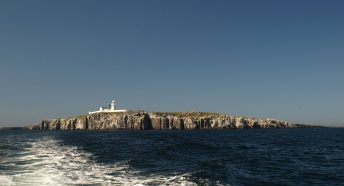The holed stone on Simonside
In an area of Northumberland full of prehistoric remnants, one object stands out in midsummer demanding our attention.
The area is south west of Rothbury where cairns top the summits of the Simonside hills and gems of rock art lie scattered around the Iron Age enclosure on Lordenshaw. But for a few days either side of the summer solstice (21 June) the holed stone (sometimes called the ‘Solstice stone’ or ‘Thompson’s rock’) on the eastern slope of Beacon Hill offers an unforgettable spectacle on fine evenings as the set sets just a few degrees west of the Cheviot.
The stone can be reached via the Simonside footpath about 700 metres from the Lordenshaws car park, on a piece of relatively flat ground halfway up the eastern flank of the hill known as the (Spylaw) Beacon, the easternmost of the Simonside hills. It lies about 100 or so metres to the right of the pathway just before it makes its final steep ascent to the cairn-topped summit.
The stone stands out amongst a number of others. One or two look placed in position but most are fairly small and randomly embedded in the uneven, heathery surface of this ‘shoulder’ of level land. Further rocks are set into the hillside which rises steeply from just metres west of the site.

The holed stone stands out and demands our attention for a number of reasons. Firstly it features prominently amongst the other rocks scattered around. It is about two metres high, with a number of flattish surfaces, including the top and bottom. Its weight (estimated at 4-5 tonnes) is greater in the upper half of the rock.
Secondly it is not resting in soil at all but is freely supported on a base of rocks set in a pit and stably balanced on at least five contact points in its position.
Even more remarkable among the rock’s features is a hole (which on initial inspection looks natural, as though formed, or smoothed, by water), running unevenly but continuously through the rock in more or less a straight line, and level at about a metre and a half above the ground. The hole is oriented and ‘sighted’ on a point fractionally above the north-west horizon where the sun sets during the midsummer solstice. When the sky is clear over this point at midsummer sunset, the sun-burst of light through the hole creates a quite spectacular sight, as particles in the interior surface of the hole act as a filter magnifying and diffracting the sun’s rays.

The stone was discovered in 1987 by the late David Thompson, a hospital radiologist, and in 2009 his colleague Crispian Oates made a detailed study in an article published in Archaeologica Aeliana. It is mentioned in Paul Frodsham’s book In the Valley of the Sacred Mountain and a television programme was made about it some years ago, presented by Maggie Philbin.
It has not, however, received the attention of a qualified archaeologist. This is a pity as the site cries out for skilled professional study. Much could be learnt from it which could throw light on a fascinating but still little-known period in our history. A serious investigation would at the very least bring this half-hidden gem out of obscurity as an object of wonder. It is a classic example of how much more Northumberland could be doing to encourage interest in, and access to, the wonderful resource we have in our countryside and its heritage treasures.







